Betaseron
Generic name: interferon beta-1b
Drug class: Interferons
Medically reviewed by A Ras MD.
What is Betaseron?
Betaseron is a prescription medicine used to treat relapsing forms of multiple sclerosis, to include clinically isolated syndrome, relapsing-remitting disease, and active secondary progressive disease, in adults. Betaseron is similar to certain interferon proteins that are produced in the body.
It is not known if Betaseron is safe and effective in children.
Description
Interferon beta-1b is a purified, sterile, lyophilized protein product produced by recombinant DNA techniques. Interferon beta-1b is manufactured by bacterial fermentation of a strain of Escherichia coli that bears a genetically engineered plasmid containing the gene for human interferon betaser17. The native gene was obtained from human fibroblasts and altered in a way that substitutes serine for the cysteine residue found at position 17. Interferon beta-1b has 165 amino acids and an approximate molecular weight of 18,500 daltons. It does not include the carbohydrate side chains found in the natural material.
The specific activity of BETASERON is approximately 32 million international units (IU)/mg interferon beta-1b. Each vial contains 0.3 mg of interferon beta-1b. The unit measurement is derived by comparing the antiviral activity of the product to the World Health Organization (WHO) reference standard of recombinant human interferon beta. Mannitol, USP and Albumin (Human), USP (15 mg each/vial) are added as stabilizers.
Lyophilized BETASERON is a sterile, white to off-white powder, for subcutaneous injection after reconstitution with the diluent supplied (Sodium Chloride, 0.54% Solution). Albumin (Human) USP and Mannitol, USP (15 mg each/vial) are added as stabilizers.
Mechanism of Action
The mechanism of action of BETASERON (interferon beta-1b) in patients with multiple sclerosis is unknown.
What is the most important information I should know about Betaseron?
Betaseron can cause serious side effects, including:
- liver problems including liver failure. Symptoms of liver problems may include:
- serious allergic reactions. Serious allergic reactions can happen quickly and may happen after your first dose of Betaseron or after you have taken Betaseron many times. Symptoms may include difficulty breathing or swallowing, swelling of the mouth or tongue, rash, itching, or skin bumps.
- depression or suicidal thoughts. Call your healthcare provider right away if you have any of the following symptoms, especially if they are new, worse, or worry you:
- thoughts about suicide or dying
- new or worse anxiety
- acting aggressive, being angry, or violent
- hallucinations
- new or worse depression
- trouble sleeping (insomnia)
- acting on dangerous impulses
- other unusual changes in behavior or mood
Who should not use Betaseron?
Do not take Betaseron if you are allergic to interferon beta-1b, to another interferon beta, to human albumin, or mannitol. See the end of this guide for a complete list of ingredients in Betaseron.
What should I tell my healthcare provider before using Betaseron?
Before you take Betaseron, tell your healthcare provider if you:
- have or have had depression (sinking feeling or sadness), anxiety (feeling uneasy, nervous, or fearful for no reason) or trouble sleeping
- have or have had liver problems
- have or have had blood problems such as bleeding or bruising easily, low red blood cells (anemia) or low white blood cells
- have or have had seizures
- have or have had heart problems
- are pregnant or plan to become pregnant.
- are breastfeeding or plan to breastfeed. It is not known if Betaseron passes into your breast milk.
Tell your healthcare provider about all the medicines you take, including prescription and nonprescription medicines, vitamins, and herbal supplements.
Know the medicines you take. Keep a list of them to show your healthcare provider and pharmacist when you get a new medicine.
How should I use Betaseron?
- See the Instructions for Use that come with Betaseron for complete information on how to use Betaseron.
- Betaseron is given by injection under your skin (subcutaneous injection) every other day.
- Take Betaseron exactly as your healthcare provider tells you to take it.
- If your healthcare provider feels that you or someone else may give you the injections then you or the other person should be trained by your healthcare provider in how to give an injection.
- Do not try to give yourself or have another person give you injections until you or both of you understand and are comfortable with how to prepare your dose and give the injection.
- You may be started on a lower dose when you first start taking Betaseron. Your healthcare provider will tell you what dose of Betaseron to use.
- Your healthcare provider may change your dose of Betaseron. You should not change your dose without talking to your healthcare provider.
- If you miss a dose, you should take your next dose as soon as you remember or are able to take it. Your next injection should be taken about 48 hours (2 days) after that dose. Do not take Betaseron on 2 consecutive days. If you accidentally take more than your prescribed dose, or take it on 2 consecutive days, call your healthcare provider right away.
- Always use a new, unopened vial of Betaseron and pre-filled diluent syringe for each injection. Throw away any unused medicine. Do not re-use any vials, syringes, or needles.
- It is important for you to change your injection site each time you inject Betaseron. This will lessen the chance of you having a serious skin reaction at the site where you inject Betaseron. Avoid injecting Betaseron into an area of skin that is sore, reddened, infected or has other problems.
What are the possible side effects of Betaseron?
Betaseron may cause serious side effects. Call your healthcare provider right away if you have any of the serious side effects of Betaseron including:
- See “What is the most important information I should know about Betaseron?”
- heart problems. Betaseron may worsen heart problems including congestive heart failure. Symptoms of heart problems may include:
- swollen ankles
- decreased ability to exercise
- shortness of breath
- fast heartbeat
- not being able to lay flat in bed
- increased need to urinate at night
- tightness in chest
- injection site problems. Serious skin reactions can happen in some people including areas of severe damage to skin and the tissue below the skin (necrosis). These reactions can happen anywhere you inject Betaseron. Symptoms of injection site problems may include swelling, redness, or pain at the injection site, fluid drainage from the injection site, and breaks in your skin or blue-black skin discoloration.
- flu-like symptoms. Betaseron can cause flu-like symptoms including:
- fever
- tiredness
- sweating
- chills
- muscle aches when you first start to use it
These symptoms may decrease over time. Taking medicines for fever and pain relief on the days you are using Betaseron may help decrease these symptoms.
- seizures. Some people have had seizures while taking Betaseron, including people who have never had seizures before. It is not known if the seizures were related to their MS, to Betaseron, or to a combination of both. If you have a seizure after taking Betaseron call your healthcare provider right away.
The most common side effects of Betaseron include:
- low white blood cell count
- headache
- pain
- increases in your liver enzymes
- increases in your muscle tension
- rash
- problems sleeping
- weakness
- stomach pain
Tell your healthcare provider if you have any side effect that bothers you or that does not go away.
These are not all the possible side effects of Betaseron. For more information, ask your healthcare provider or pharmacist.
Call your doctor for medical advice about side effects. You may report side effects to FDA at 1-800-FDA-1088.
General information about the safe and effective use of Betaseron
Medicines are sometimes prescribed for purposes other than those listed in a Medication Guide. Do not use Betaseron for a condition for which it was not prescribed. Do not give Betaseron to other people, even if they have the same symptoms that you have. It may harm them.
This Medication Guide summarizes the most important information about Betaseron. If you would like more information, talk with your healthcare provider. You can ask your pharmacist or healthcare provider for information about Betaseron that is written for health professionals.
For more information, go to www.BETASERON.com or call Betaplus, the Betaseron patient support program, at 1-800-788-1467.
How should I store Betaseron?
- Before mixing, store Betaseron at room temperature between 68°F to 77°F (20°C to 25°C).
- Before mixing, Betaseron may be stored for up to 3 months between 59°F to 86°F (15°C to 30°C).
- After mixing, you can refrigerate Betaseron for up to 3 hours before using. Your Betaseron must be used within 3 hours of mixing even if refrigerated.
- Do not freeze.
Keep Betaseron and all medicines out of the reach of children.
What are the ingredients in Betaseron?
Active ingredient: interferon beta-1b
Inactive ingredients: albumin (human), mannitol
Diluent contains sodium chloride solution.
Instructions for use for Betaseron
(bay-ta-seer-on)
interferon beta-1b
(in-ter-feer-on beta-one-be)
Read the Instructions for Use that come with your Betaseron before you start using it and each time you get a refill. There may be new information. This guide does not take the place of talking to your healthcare provider about your medical condition or treatment. Before you use Betaseron for the first time, make sure your healthcare provider shows you the right way to use it.
Supplies needed for your Betaseron Injection (See Figure A).
- 1 single-use carton containing:
- A vial of Betaseron
- A pre-filled diluent syringe
- A vial adapter with a 30-gauge needle attached (in the blister pack)
- 2 alcohol prep pads
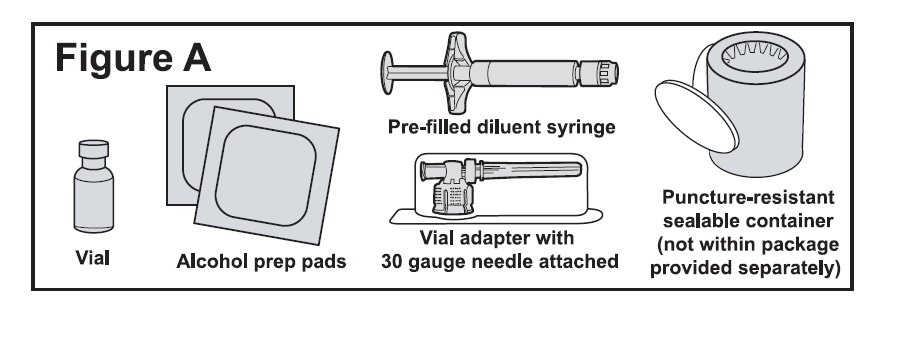
Step 1: Preparing for Your Betaseron Injection
- Place the supplies you will need on a clean, flat surface in a well-lit area.
- Check the expiration date on the single-use carton to make sure that it has not expired. Do not use it if the medication has expired.
- Wash your hands thoroughly with soap and water.
- Open the single-use carton and take out all the contents. Make sure the blister pack containing the vial adapter is sealed. Check to make sure the plastic cap on the pre-filled diluent syringe is firmly attached.
- Remove the tray from the single-use carton and place it on a flat surface.
- Place the Betaseron vial in the well (vial holder) and place the pre-filled diluent syringe in the U-shaped trough (See Figure B).
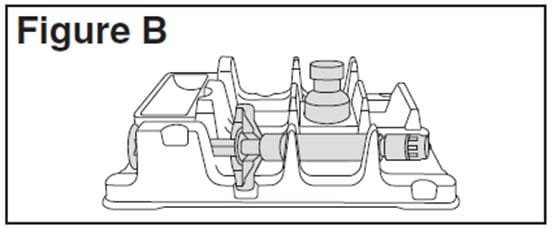
Step 2: Mixing Betaseron
- Remove the Betaseron vial from the well (vial holder) and take the cap off the vial.
- Place the vial back into the well (vial holder).
- Use an alcohol prep pad to clean the top of the vial. Move the alcohol prep pad in 1 direction. Leave the alcohol prep pad on top of the vial.
- Peel the label off the blister pack with the vial adapter in it. The vial adapter is sterile. Do not remove or touch the vial adapter.
- Remove the alcohol prep pad from the top of the Betaseron vial. Pick up the vial adapter in the blister pack. Turn over the blister pack keeping the vial adapter inside. Put the adapter on top of the Betaseron vial. Push down on the adapter until it pierces the rubber top of the Betaseron vial and snaps in place (See Figure C). Remove the blister packaging from the vial adapter.
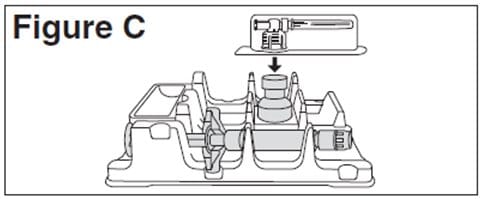
- Twist the plastic cap from the pre-filled diluent syringe. Throw away the plastic cap. (See Figure D).
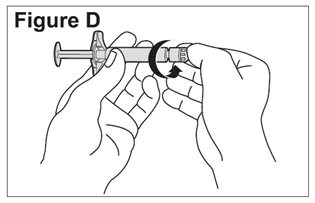
- Keep the vial adapter attached to the vial and remove the vial from the well (vial holder). Be careful not to pull the vial adapter off the top of the vial.
- Connect the pre-filled diluent syringe to the vial adapter by turning clockwise until resistance is felt and the attachment is secure. This forms the syringe assembly (See Figure E).
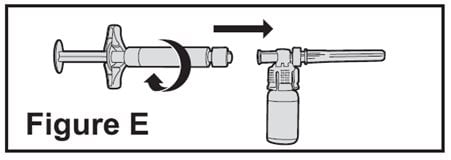
- Slowly push the plunger of the pre-filled diluent syringe all the way in. This will transfer all of the liquid from the syringe into the Betaseron vial (See Figure F). The plunger may return to its original position after you release it.
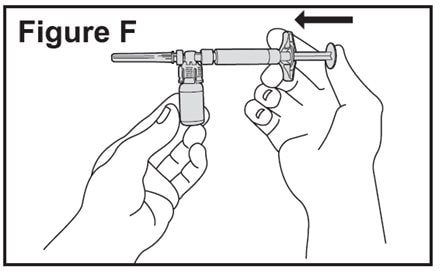
- Gently swirl the vial to completely dissolve the white powder of Betaseron. Do not shake. Shaking and even gentle mixing can cause foaming of the medicine. If there is foam, let the vial sit until the foam settles before using it.
- After the powder dissolves, look closely at the solution in the vial. Do not use the solution if it is cloudy or contains particles. It should be clear and colorless.
- Do not use cracked or damaged Betaseron vials. If your vial is cracked or damaged, get a new single-use carton containing a Betaseron vial, pre-filled diluent syringe, vial adapter and 2 alcohol prep pads. Repeat the steps to prepare your Betaseron dose.
- Contact Betaplus, the Betaseron patient support program, at 1-800-788-1467 to obtain a replacement product.
Step 3: Preparing the Injection
You have completed the steps to prepare your Betaseron and are ready for the injection. The injection should be given immediately after mixing and allowing any foam in the solution to settle. If you must wait to give yourself the injection, you may refrigerate the solution and use within 3 hours of mixing your Betaseron. Do not freeze.
- Push the plunger in and hold it there; then turn the syringe assembly so that the syringe is horizontal and the vial is on top.
- Slowly pull the plunger back to withdraw all the liquid from the Betaseron vial into the syringe (See Figure G).
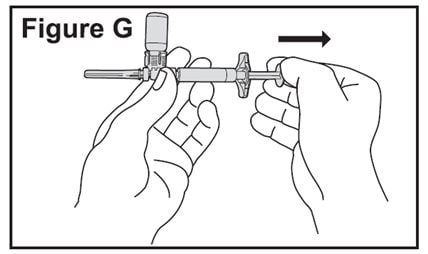
- NOTE: The syringe barrel is marked with numbers from 0.25 mL to 1 mL (See Figure H). If the solution in the vial cannot be drawn up to the 1 mL mark, discard the vial and syringe and start over with a new single-use carton containing a Betaseron vial, pre-filled diluent syringe, vial adapter and alcohol prep pads.
- Turn the syringe assembly so that the needle end is pointing up. Remove any air bubbles by tapping the outside of the syringe with your fingers. Slowly push the plunger to the 1 mL mark on the syringe or to the mark that matches the amount of Betaseron prescribed by your healthcare provider (See Figure H). If too much solution is pushed into the vial, repeat Step 3.
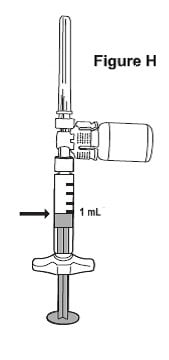
- Turn the syringe assembly so that the vial is at the bottom. Remove the vial adapter and the vial from the syringe by twisting the vial adapter. This will remove the vial adapter and the vial from the syringe, but will leave the needle on the syringe (See Figure I).
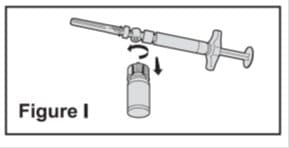
Step 4: Choosing an Injection Site
- Betaseron (interferon beta-1b) is injected under the skin and into the fat layer between the skin and the muscles (subcutaneous tissue). The best areas for injection are where the skin is loose and soft and away from the joints, nerves, and bones. Do not use the area near your navel or waistline. If you are very thin, use only the thigh or outer surface of the arm for injection.
- Choose a different site each time you give yourself an injection. Figure J shows different areas for giving injections. Do not inject in the same area for 2 injections in a row. Keep a record of your injections to help make sure you change (rotate) your injection sites. You should decide where you will inject Betaseron before you prepare your medicine for injection. If there are any sites that are difficult for you to reach, you can ask someone who has been trained to give the injection to help you.
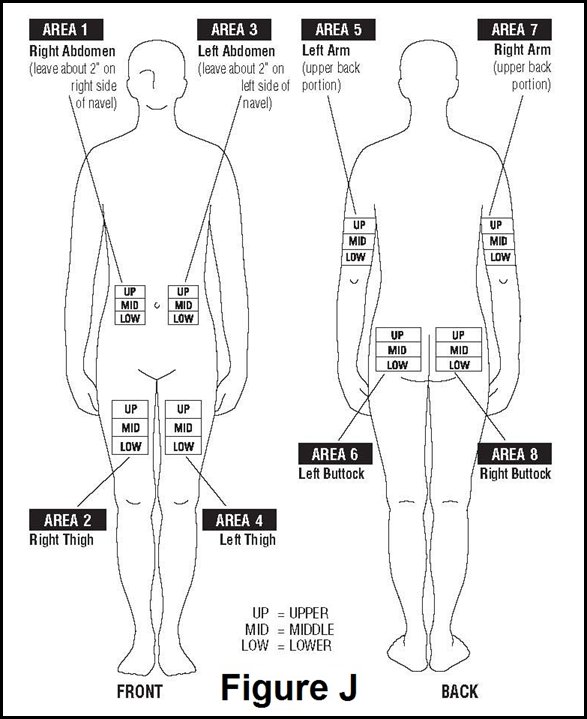
- Do not inject Betaseron in a site where the skin is red, bruised, infected, or scabbed, has broken open, or has lumps, bumps, or pain. Tell your healthcare provider if you find skin conditions like the ones mentioned here or any other unusual-looking areas where you have been given injections.
Step 5: Injecting Betaseron
- Using a circular motion, clean the injection site with an alcohol prep pad, starting at the injection site and moving outward. Let the skin area air dry.
- Remove the cap from the needle. Hold the syringe like a pencil or dart in 1 hand.
- Gently pinch the skin around the site with the thumb and forefinger of the other hand (See Figure K). Insert the needle straight up and down into your skin at a 90° angle with a quick, dart-like motion.
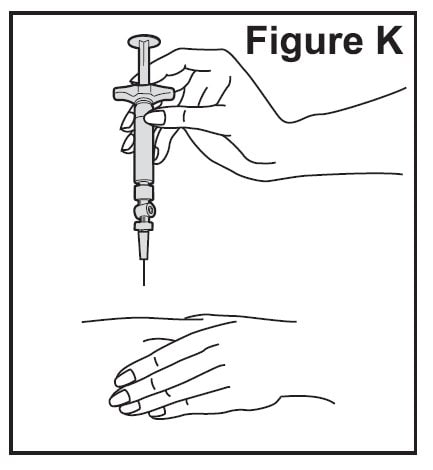
- Slowly push the plunger all the way in until the syringe is empty (See Figure L).
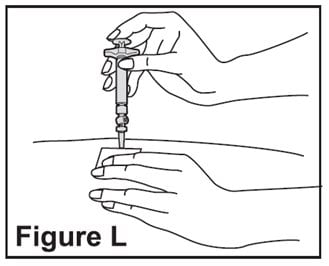
- Remove the needle from the skin. Place a dry cotton ball or gauze pad over the injection site. Gently massage the injection site for a few moments with the dry cotton ball or gauze pad. Throw away the syringe in your puncture-proof disposal container.
- Optional Use of BetaConnect Autoinjector:
You may also give Betaseron by using the BetaConnect autoinjector. You should get help with training on the use of the BetaConnect autoinjector from a healthcare provider before using it for the first time. The BetaConnect autoinjector should only be used with the syringes that come in the Betaseron packaging. See the Instructions for Use that come with the BetaConnect autoinjector. For more information, call Betaplus, the Betaseron patient support program, at 1-800-788-1467.
Step 6: Disposing of used syringes, needles, and vials
- To prevent needle-stick injury and spread of infection, do not try to re-cap the needle.
- Place used needles, syringes, and vials in a closeable, puncture-resistant container. You may use a sharps container (such as a red biohazard container), hard plastic container (such as a detergent bottle), or metal container (such as an empty coffee can). Do not use glass or clear plastic containers. Ask your healthcare provider for instructions on the right way to throw away (dispose of) the container. There may be state and local laws about how you should throw away used needles and syringes.
- Do not throw used needles, syringes, or vials in your household trash or recycle.
- Throw away any unused medicine. Do not save any unused Betaseron for a future dose.
- Keep the disposal container, needles, syringes, and vials of Betaseron out of the reach of children.
Label
PRINCIPAL DISPLAY PANEL
- The principal display panel is a representative example and may not reflect the most current label.
- NDC 50419-524-01 Rx only
- BETASERON
(interferon beta-1b) - For injection
- 0.3 mg per vial
- For subcutaneous injection
- No U.S. standard of potency
- Single use carton
- Contains:
- •
- 1 single-use vial for reconstitution
- •
- 1 pre-filled single-use sodium chloride 0.54% solution diluent syringe
- •
- 1 vial adapter with a 30 gauge needle attached
- •
- 2 alcohol prep pads

SRC: NLM .
